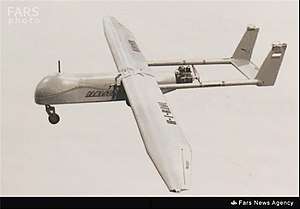Hamaseh
The HESA Hamaseh (Persian: حماسه, romanized: Ḥamāseh, lit. 'Epic') is an Iranian tactical and reconnaissance unmanned aerial vehicle (UAV) with high flight endurance built by Iran Aircraft Manufacturing Industrial Company (HESA).[2] The Hamaseh was unveiled in 2013 and entered service in 2016.
| HESA Hamaseh | |
|---|---|
 | |
| Role | tactical surveillance |
| National origin | Iran |
| Manufacturer | Iran Aircraft Manufacturing Industrial Company (HESA) |
| Design group | HESA |
| First flight | ? |
| Status | In service |
| Primary user | Iranian Armed Forces |
| Produced | 2013–present? |
| Number built | 30 (2013)[1] |
Design
The Hamaseh is a single engine, twin-boom UAV.[3] The UAV features a bulbous forward radome; this was later reduced in size as the UAV was developed. The Hamaseh entered service with Iran in 2016.[3]
The Hamaseh can carry up to 185 kg of fuel, equipment, and payload, and has an endurance of up to 11 hours depending on configuration.[2] It is launched via runway takeoff or JATO,[2] and is recovered by runway landing or, in emergencies, a parachute.[3] The Hamaseh can follow pre-determined waypoints to control its flight.[2] Its powerplant is unknown.[3]
The Hamaseh can carry synthetic aperture radar, radar or communications jammers, and a camera. For weapons, it can carry small bombs, grenades, or rockets.[3]
Operational history
.jpg)
The Hamaseh drone was unveiled on 9 May 2013. Ahmad Vahidi, Iran's defense minister, claimed the drone "with its stealth quality can avoid detection by the enemy." The Hamaseh was also claimed to be a High-Altitude Long Endurance (HALE) platform, despite being a tactical UAV.[4] The Hamaseh at its unveiling ceremony was "equipped" with what appeared to be munitions, but they were physically bolted to the wings, not mounted on hardpoints.[4]
.jpg)
The Hamaseh was first used during military exercises by the IRGC Ground Forces in April 2016.[4]
In 2017 HESA offered the Hamaseh for export.[3]
Specifications
Data from Иранская экспозиция на МАКС-2017. Часть.2[2][lower-alpha 1]
General characteristics
- Length: 5.05 m (16 ft 7 in)
- Width: 9 m (29 ft 6 in)
- Height: 1.9 m (6 ft 3 in)
- Empty weight: 230 kg (507 lb)
- Gross weight: 415 kg (915 lb)
Performance
- Maximum speed: 194 km/h (121 mph, 105 kn)
- Cruise speed: 165 km/h (103 mph, 89 kn)
- Stall speed: 110 km/h (68 mph, 59 kn)
- Combat range: 200 km (120 mi, 110 nmi)
- Endurance: up to 11 h (depending on payload)
- Service ceiling: 4,600 m (15,000 ft)
- Rate of climb: 4 m/s (790 ft/min)
References
- Nasim Online [@NasimOnline_Ir] (6 May 2013). "Iran Defense Ministry: We have manufactured 30 "Hamaseh" drones so far" (Tweet) – via Twitter.
- Yuri Lyamin (21 July 2017). "Иранская экспозиция на МАКС-2017. Часть.2".
- Stephen Trimble (18 July 2017). "Iran puts Hamaseh UAV on export market". Flightglobal.com. Moscow.
- Gareth Jennings (14 April 2016). "Iran debuts Hamaseh unmanned aircraft". IHS Jane's Defence Weekly. London: IHS Jane's 360. Archived from the original on 18 April 2016.
- Arda Mevlutoglu [@orko_8] (26 April 2018). "Hamaseh UAV Iran" (Tweet) – via Twitter.
- This data is from the 2017 MAKS airshow. Specifications for the Hamaseh at the 2018 Eurasia Air Show were slightly different;[5] I don't know why or care.